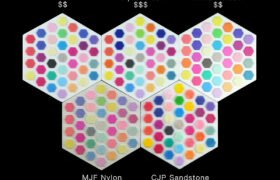Not all full-color 3D prints are created equal. Whether you’re prototyping a product, designing a figurine, or building a model for education or art, choosing the right 3D printing technique can make or break your colors. Here’s a quick deep dive into five of the most popular full-color 3D printing technologies.
Case 1: Color swatches
WJP Resin ($$)
- Support Required: Yes
- Color Performance: Warm tones tend to skew pink; orange prints appear magenta.
- Edge Definition: Very clear and sharp.
- Surface Texture: Smooth and matte, with very subtle vertical striations.
- Color Uniformity: Consistent across surfaces.

PolyJet Resin ($$$)
- Support Required: Yes
- Color Performance: Slightly lighter overall tones. Some color bleeding or ghosting at edges.
- Edge Definition: Less crisp compared to WJP.
- Surface Texture: Smooth and matte. Under close inspection, the surface shows fine speckling, giving a faint uneven appearance in photos (but it’s physically flat).
- Color Uniformity: Good but minor noise visible up close.

Mimaki Resin ($$$)
- Support Required: Yes
- Color Performance: Bright and vivid, although slightly lighter overall due to lighting reflection. High saturation.
- Edge Definition: Sharp.
- Surface Texture: Smooth with a noticeable gloss.
- Color Uniformity: Very even, with occasional tiny imperfections.
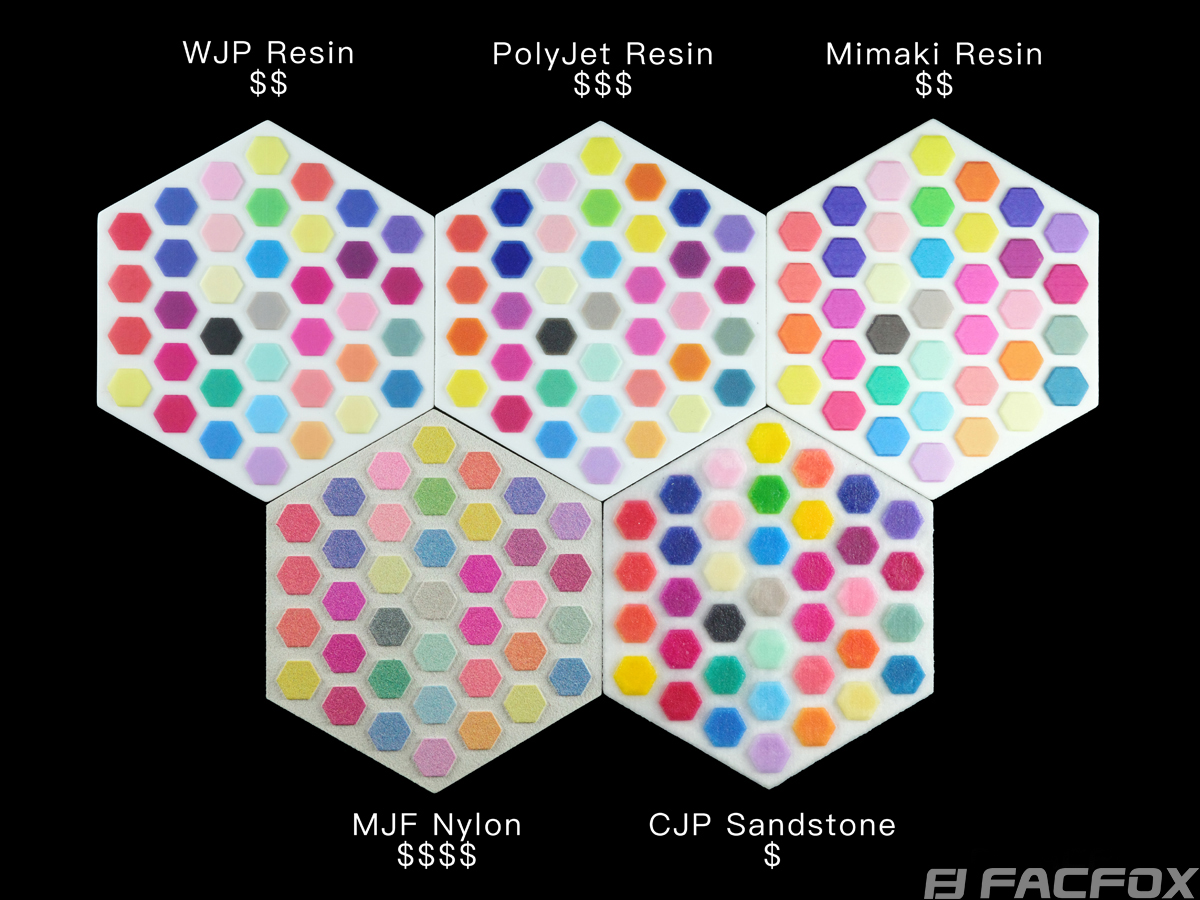
MJF Nylon ($$$$)
- Support Required: No (powder supports itself)
- Color Performance: Muted and soft overall, colors lean a little gray. Some warm colors shift slightly pink.
- Edge Definition: Clear but slightly powdery appearance.
- Surface Texture: Matte and grainy, resembling pastel or colored chalk artwork.
- Color Uniformity: Decent, but less vibrant than resin-based prints.
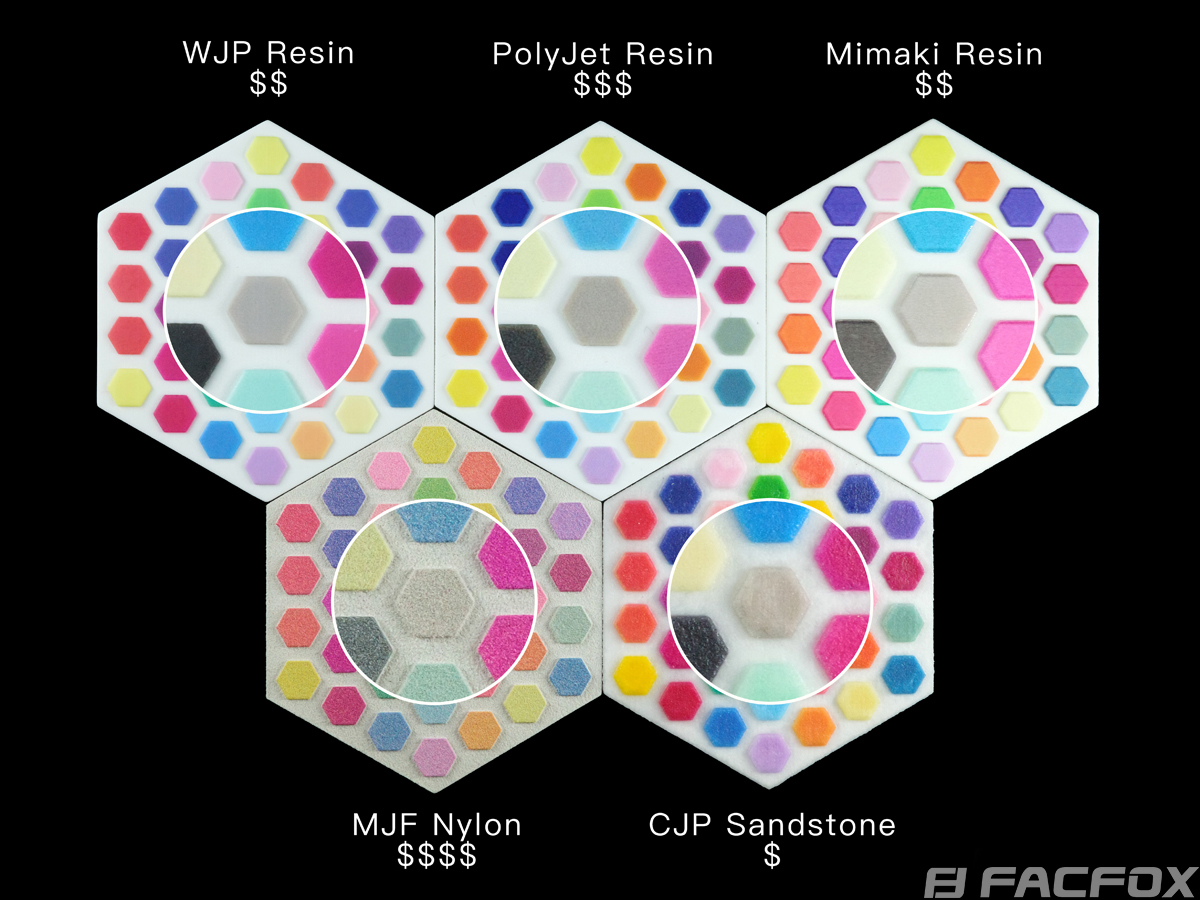
CJP Sandstone ($)
- Support Required: No (powder supports itself)
- Color Performance: High contrast – dark tones are darker, light tones are lighter.
- Edge Definition: Blurred and less sharp.
- Surface Texture: More glossy than MJF Nylon but not smooth – visible surface roughness causes light scattering.
- Color Uniformity: Saturated but less consistent due to the rough texture.
Case 2: Henry the fox mascot miniature
Testing on a detailed cartoon model reveals even more about how each full-color printing technique behaves:
MJF Nylon ($$$$)
- Color Performance: Lowest saturation; colors look grayish and muted.
- Surface Texture: Rough, matte, sandpaper-like feel.
- Detail Definition: Clear shapes but lacks color vibrancy.
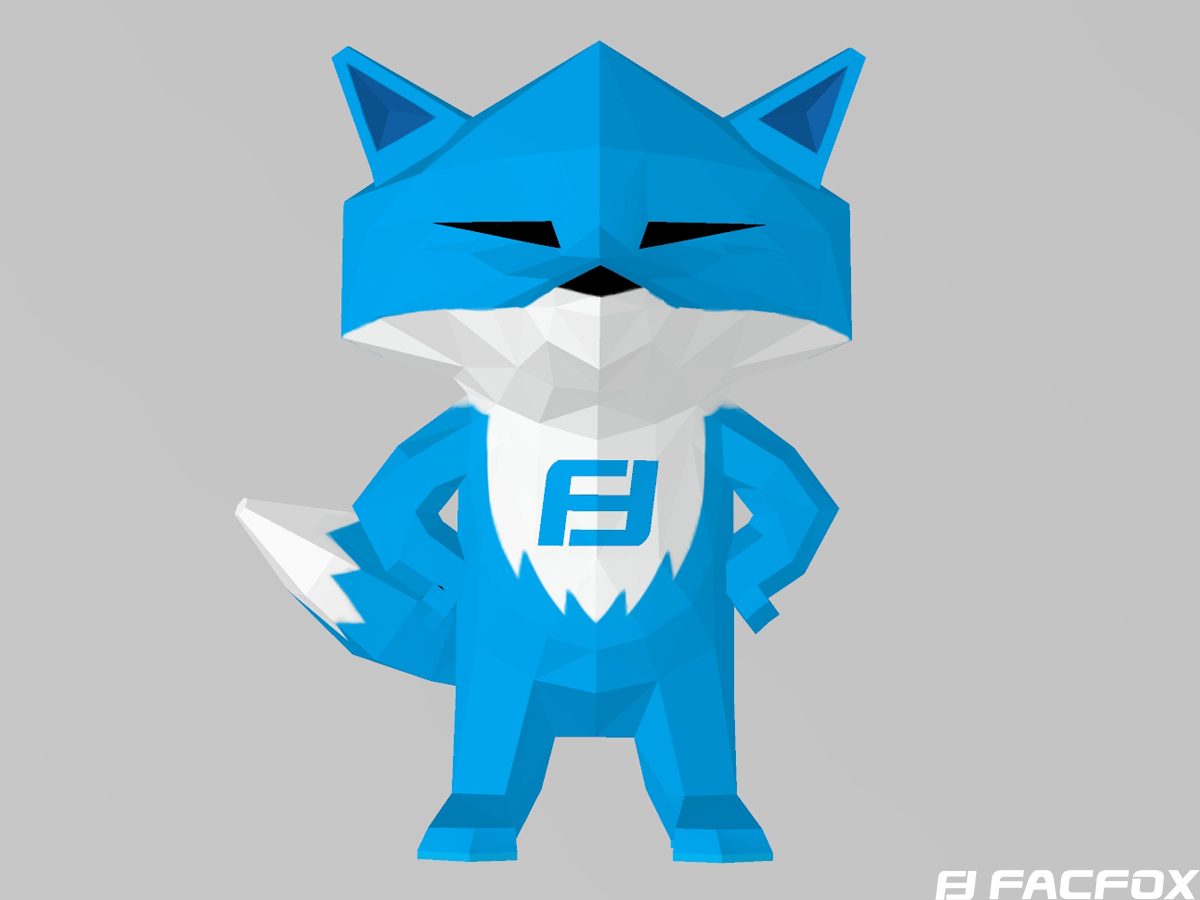
CJP Sandstone ($)
- Color Performance: High saturation; blue areas are darker than intended.
- Surface Texture: Rougher than MJF Nylon, with a gritty feel.
- Detail Definition: Color bleeding at edges – transitions are blurry (e.g., eyes and chest logo overflow).
WJP Resin ($$)
- Color Performance: Most accurate to the original 3D model, especially for blues.
- Surface Texture: Smooth and matte.
- Detail Definition: Sharp edges, minimal color bleeding – excellent at preserving small design details.
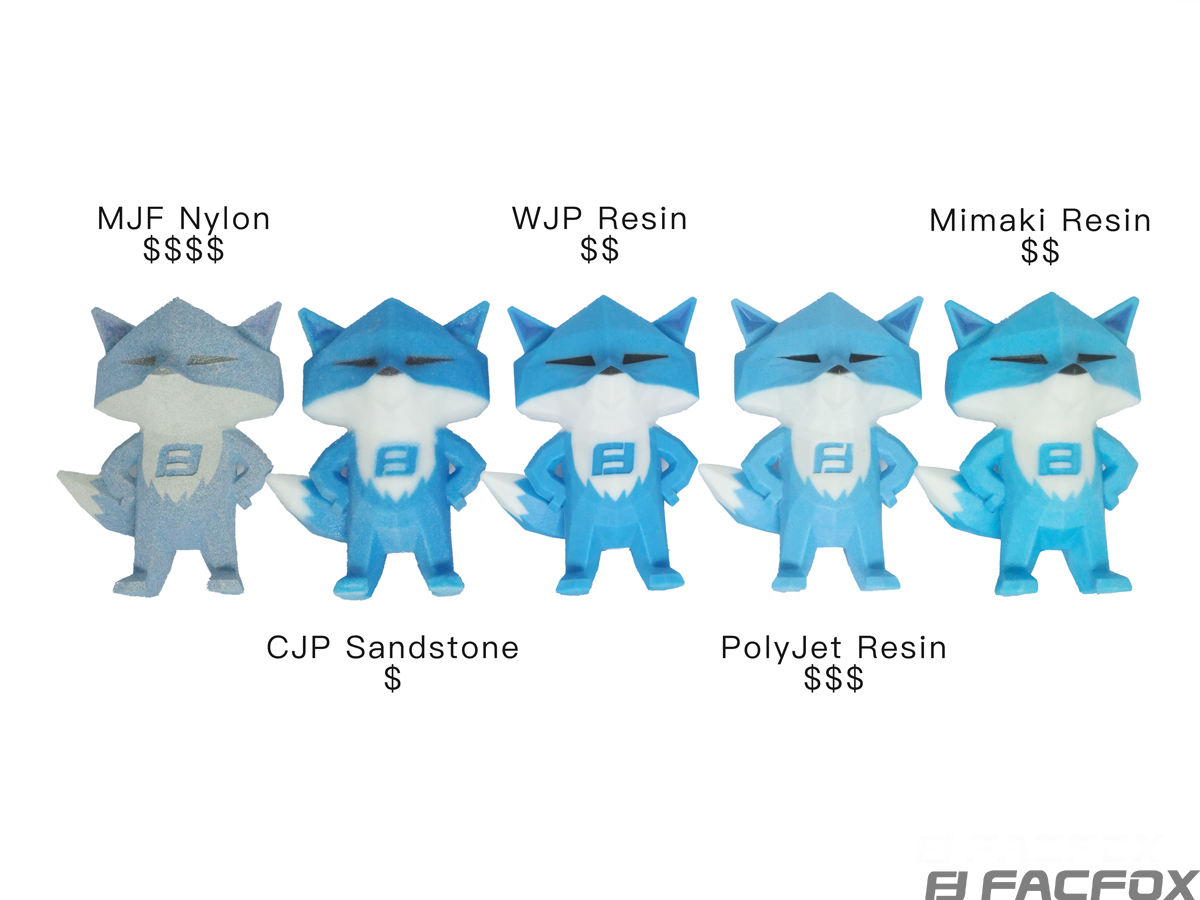
PolyJet Resin ($$$)
- Color Performance: Lightest colors among all; slightly washed-out look.
- Surface Texture: Smooth and matte.
- Detail Definition: Color tends to “bleed outward” from large to small areas, causing small features (like eyes or chest logos) to shrink slightly.
Mimaki Resin ($$)
- Color Performance: Blue shades shift slightly green.
- Surface Texture: Smooth and slightly glossy.
- Detail Definition: Opposite of PolyJet – color from small features “bleeds outward” into surrounding areas, making small details (eyes, nose, etc.) appear larger, sometimes losing fine gaps (like the chest logo white spaces).
Case 3: Elder Male Head Miniature
When printing human faces, color accuracy and detail clarity become even more critical. Here’s what we observe:
CJP Sandstone ($)
- Color Performance: Highest saturation; skin tones shift strongly toward red.
- Surface Texture: Very rough, similar to sandstone.
- Detail Definition: Features like facial features and hairline are blurred; edges are soft.
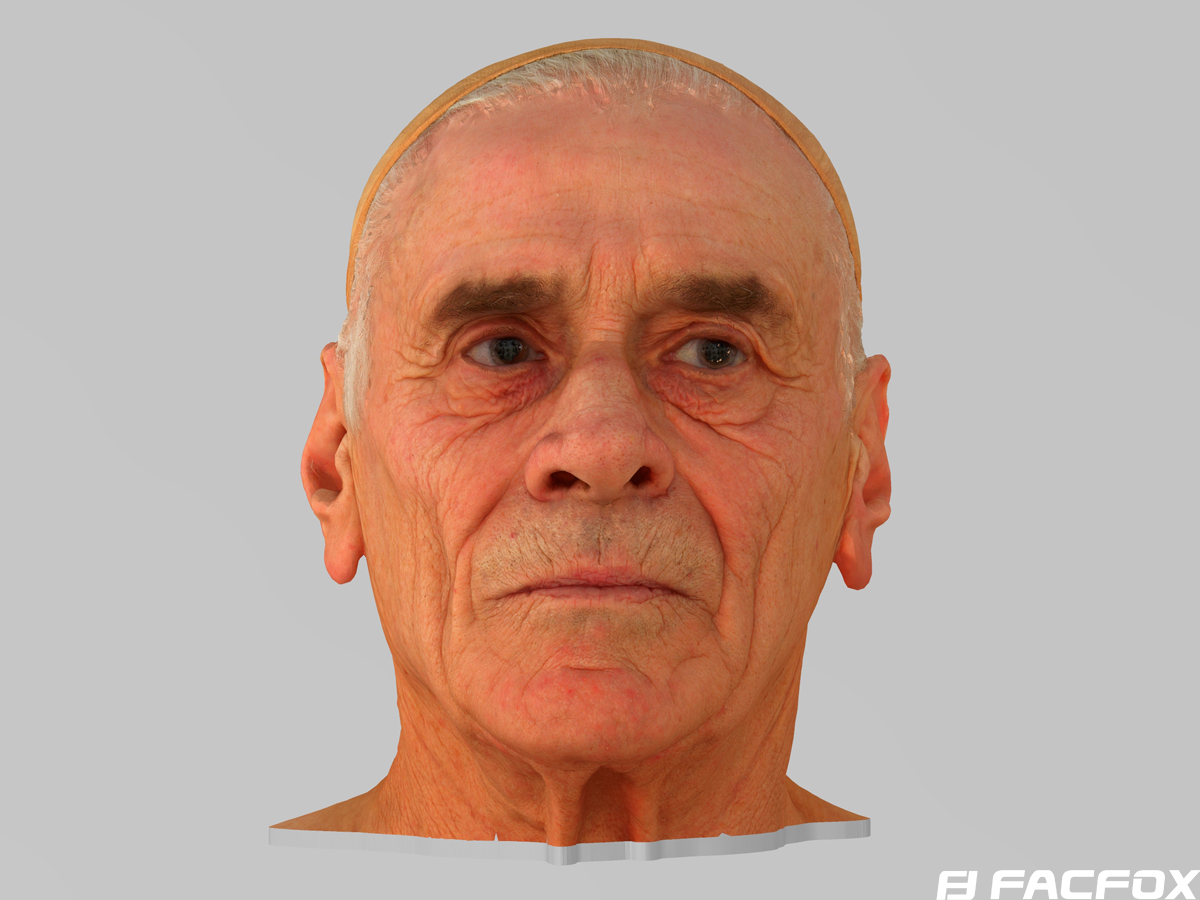
MJF Nylon ($$$$)
- Color Performance: Lowest saturation; colors look pale with a lot of grayish noise.
- Surface Texture: Matte and grainy.
- Detail Definition: Difficult to recognize finer details because of the muted and grainy look.
WJP Resin ($$)
- Color Performance: Skin tone leans slightly magenta (pinkish).
- Surface Texture: Smooth and matte.
- Detail Definition: Cornea and pupil edges are clearly defined, making the eyes sharper than most other technologies.
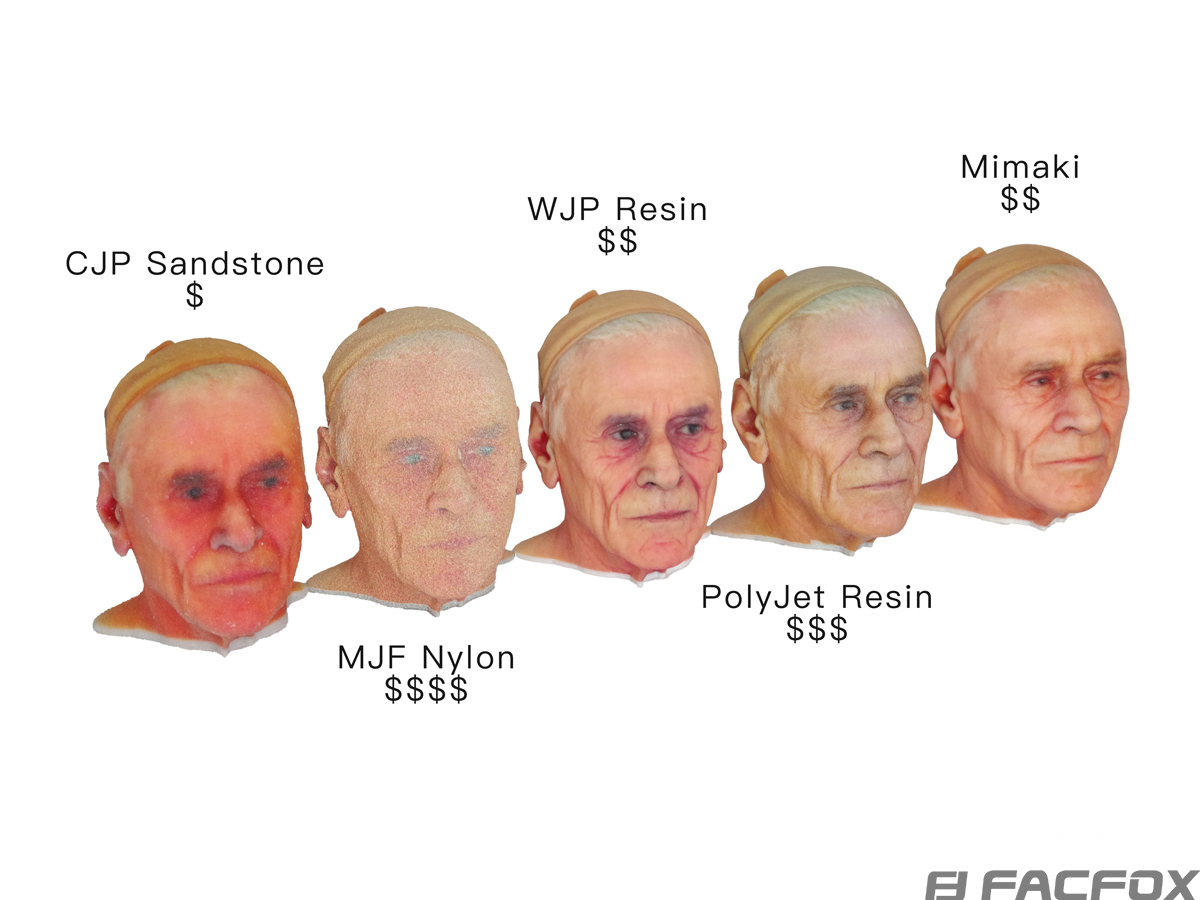
PolyJet Resin ($$$)
- Color Performance: Lower saturation; skin tone appears slightly yellowish.
- Surface Texture: Smooth.
- Detail Definition: Dark colors like the eyebrows and pupils bleed outward, sometimes affecting surrounding areas like the bridge of the nose, slightly blurring nearby fine details.
Mimaki Resin ($$)
- Color Performance: Skin tones most faithful to the original 3D model.
- Surface Texture: Smooth with a subtle gloss.
- Detail Definition: Best among all five – clear definition of all facial details. However, the cornea is printed lighter, making the pupils appear smaller than in other prints.
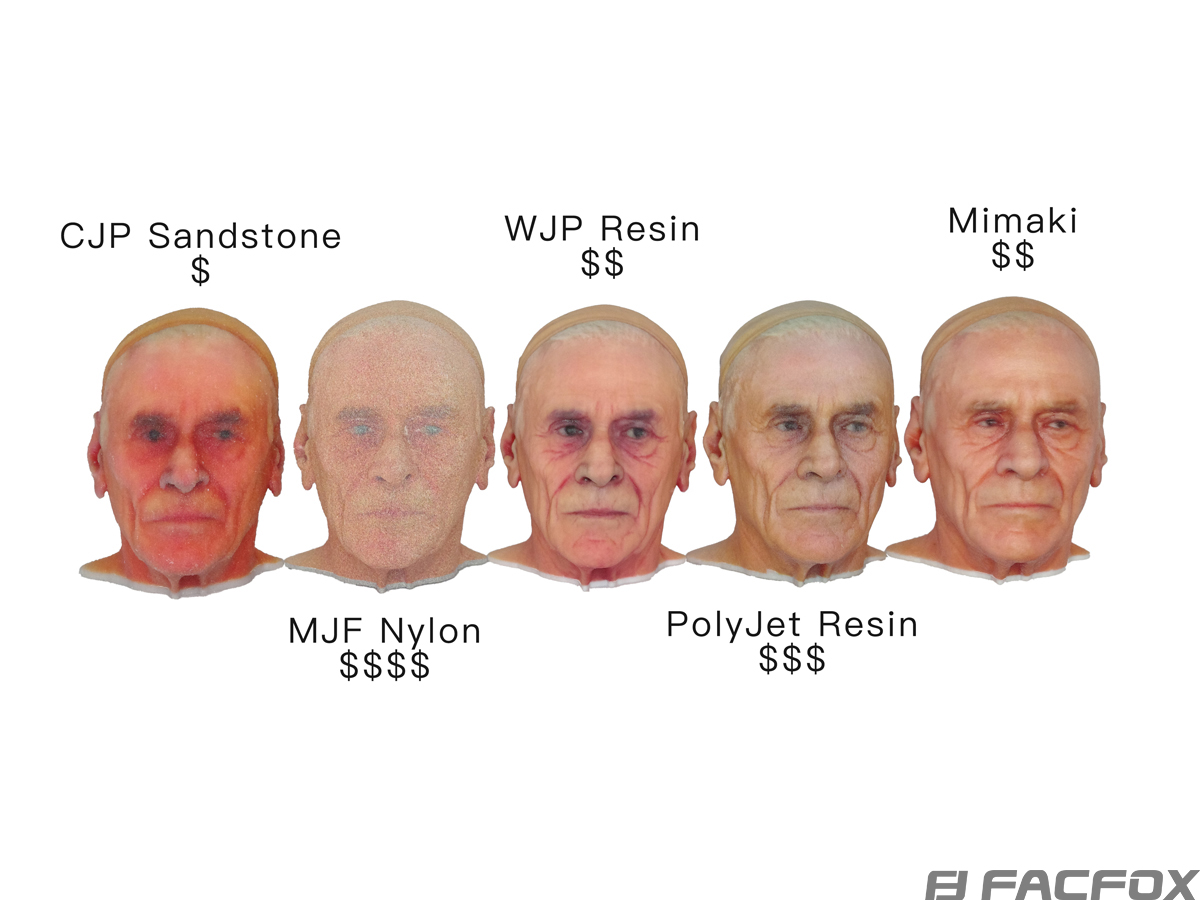
Case 4: Elder Female Head Miniature
CJP Sandstone
- Color: Vibrant, but skin tones are overly red.
- Surface: Grainy and coarse.
- Details: Struggles with clarity, as details like facial features and hairlines appear blurred and lack sharpness.
MJF Nylon
- Color: Muted with gray-white speckles.
- Surface: Powdery and rough.
- Details: Details are difficult to discern due to speckles and low color contrast, making it less suitable for fine, intricate designs.
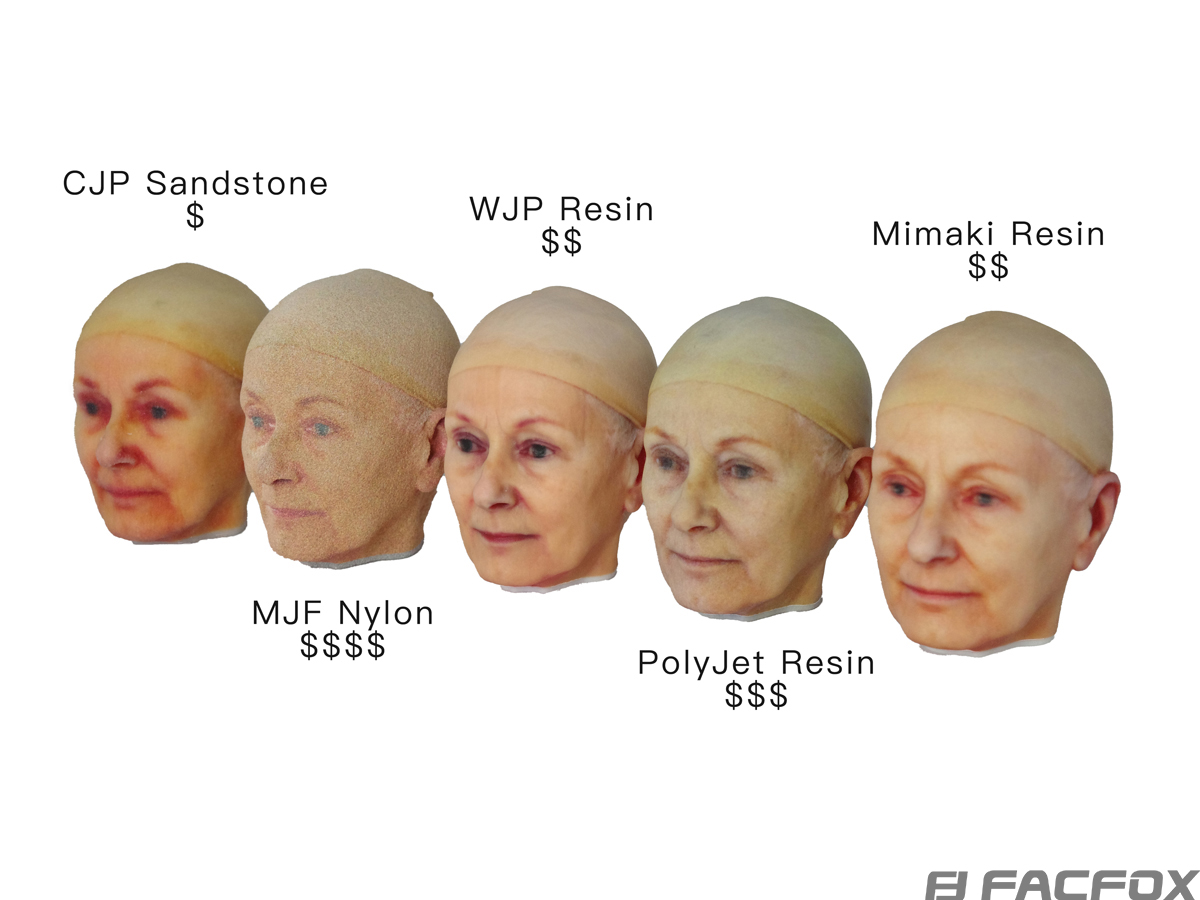
WJP Resin
- Color: Vibrant but slightly inaccurate, some bleeding.
- Surface: Smooth with minor imperfections.
- Details: Provides moderate clarity, with visible details, though color inconsistencies may slightly obscure finer elements.
PolyJet Resin
- Color: Subdued, yellow-green skin tones.
- Surface: Smooth but not polished.
- Details: Achieves reasonable detail clarity, though the muted colors can make subtler features appear less pronounced.
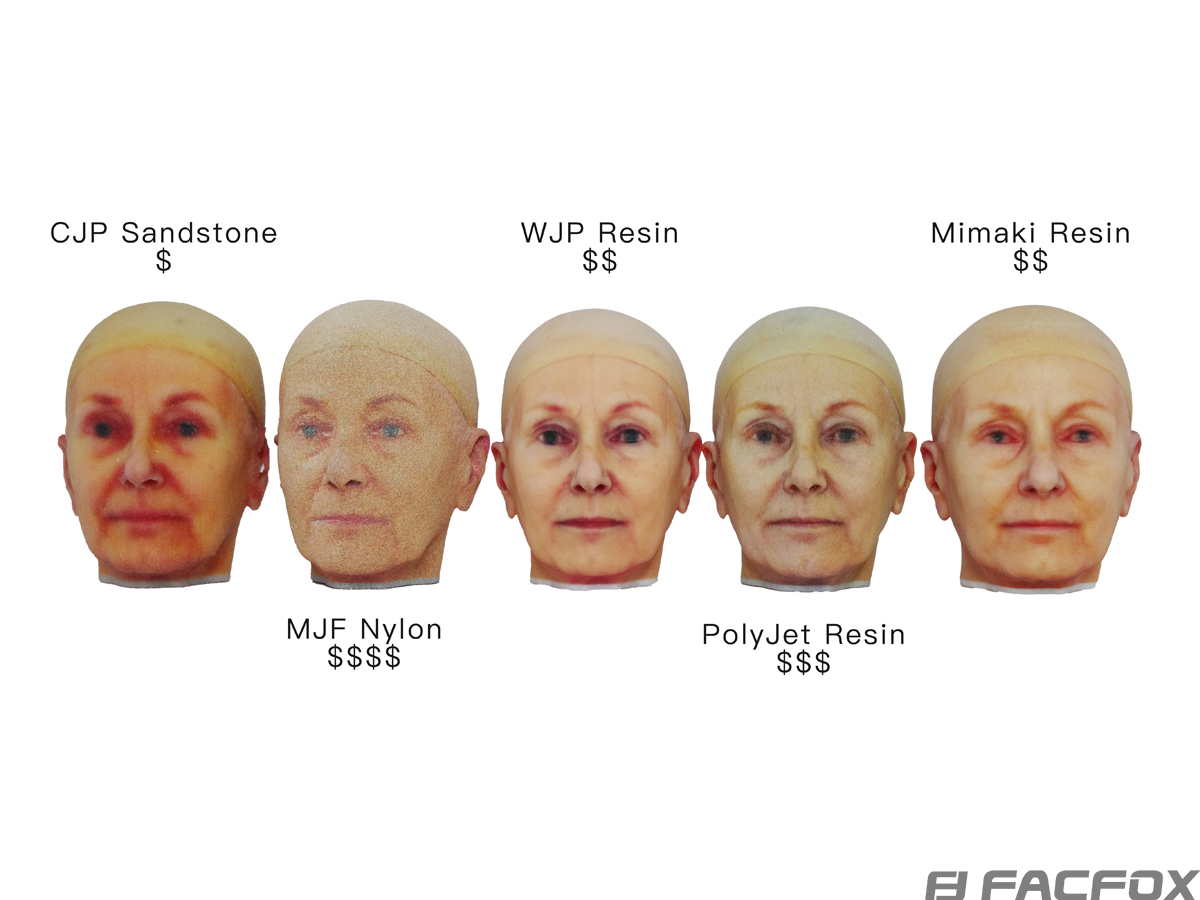
Mimaki
- Color: Most accurate and natural.
- Surface: Smooth and refined.
- Details: Provides the sharpest detail clarity, accurately capturing intricate features like facial expressions and textures.
Case 5: Wall thickness test strip
CJP Sandstone
- Color Performance: Displays high color saturation but struggles with precise detail rendering.
- Surface Texture: Coarse texture with notable issues like broken borders.
- Detail Definition: Failed to print finer details, including the 0.2mm thick sections, highlighting its limitations for intricate designs.
MJF Nylon
- Color Performance: Muted, with grayish tones and low saturation.
- Surface Texture: Nearly opaque and uniform, offering good durability.
- Detail Definition: Successfully printed 0.2mm sections and displayed clear embossed text details, making it suitable for functional precision.
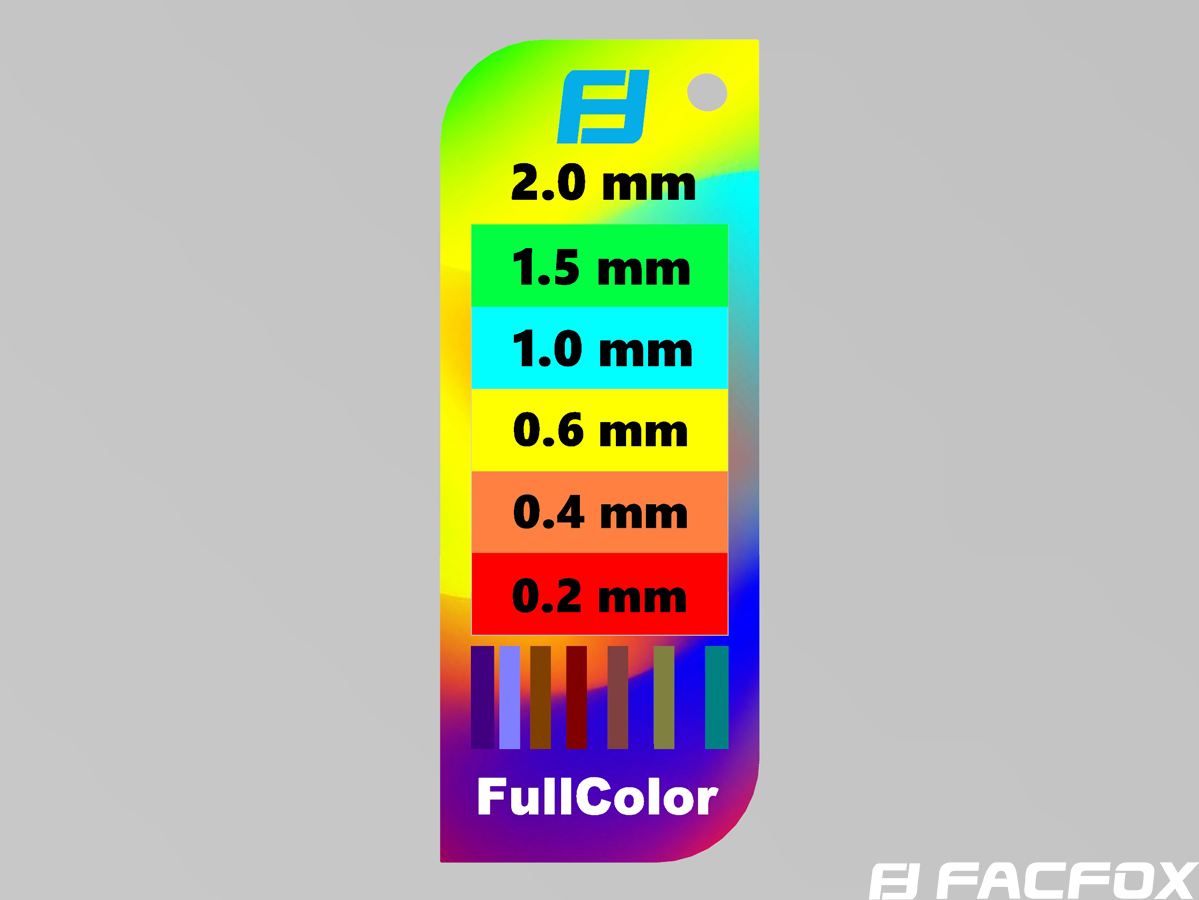
WJP Resin
- Color Performance: Leans toward blue tones, with darker shades in blue regions.
- Surface Texture: Moderate smoothness but experienced breakage in thinner sections like the 0.2mm and 0.4mm parts.
- Detail Definition: Embossed text was rendered well, but thinner edges suffered from structural failure.
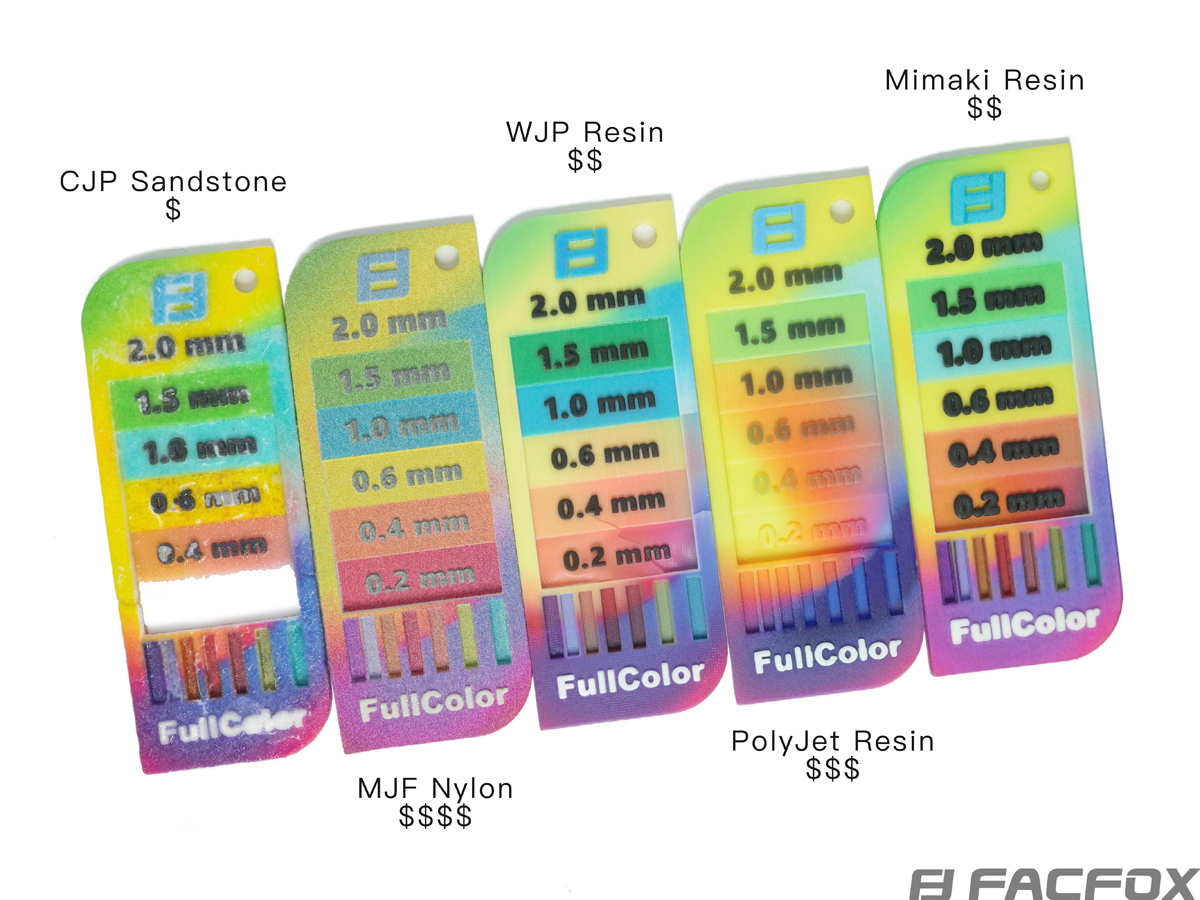
PolyJet Resin
- Color Performance: Thin layers were semi-translucent, with noticeable challenges in achieving uniform color application for thinner sections. Colors overflow significantly in areas with varying wall thickness.
- Surface Texture: Smooth but less refined due to translucency issues in thinner layers.
- Detail Definition: Printed the 0.2mm sections but struggled with contrast and precision for black embossed text, which became increasingly faint with thinner layers.
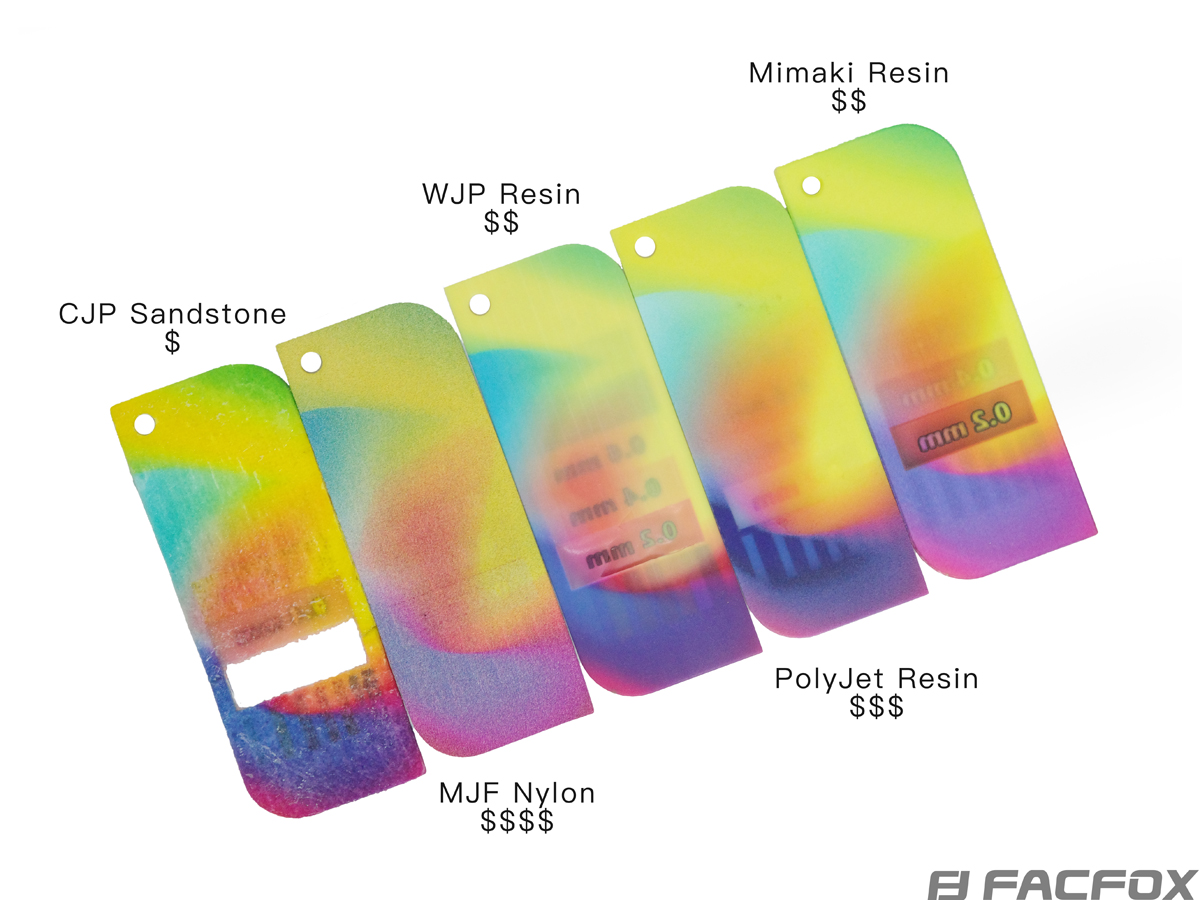
Mimaki
- Color Performance: High saturation and excellent color fidelity overall, but small areas experienced minor color bleeding.
- Surface Texture: Smooth and consistent, although some identifiers on thinner layers appeared blurred.
- Detail Definition: Successfully printed 0.2mm sections with fine features, but clarity was slightly compromised by color overflow.
Conclusion
- For best color sharpness and surface smoothness: Mimaki Resin or WJP Resin
- For cost-effective color models (non-functional, display only): CJP Sandstone
- For soft, artistic, durable parts: MJF Nylon
- For versatile color prototypes with decent detail: PolyJet Resin
At FacFox, we offer all five of these cutting-edge full-color 3D printing technologies-backed by expert guidance, fast turnaround, and deep knowledge of each material’s behavior. Whether you’re creating vivid product mockups, figurines, architectural models, or educational tools, we help you bring your vision to life with accurate, vibrant results.
| Technology | Quote (USD/cm³) | Material | Supporting Structure |
| WJP (White Jet Process) | 1.2-1.5 ($$) | Resin | Yes |
| PolyJet | 1.4-1.8 ($$$) | Resin | Yes |
| Mimaki | 1.2-1.5 ($$) | Resin | Yes |
| MJF (Multi Jet Fusion) | 4-5 ($$$$) | Nylon | No as powder could support itself |
| CJP (ColorJet Printing) | 1-1.4 ($) | Sandstone-like Plaster | No as powder could support itself |
Ready to print in full color? Visit FacFox.com to explore materials, get instant quotes, or talk to our specialists. Your perfect print is just a few clicks away!
